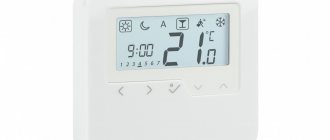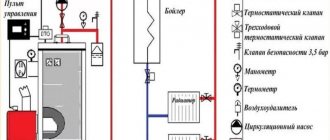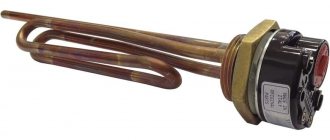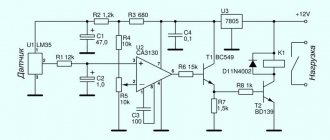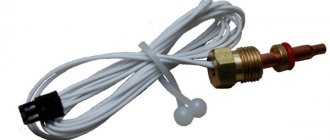The automation of a modern gas boiler is becoming more complex and more advanced every year. The heater today automatically maintains the set coolant temperature.
Due to such devices, the premises have a high level of comfort, especially if they are equipped with remote thermostats. After all, it’s not the temperature in the pipes that’s important to us—we’re interested in the air temperature in the rooms.
Wireless thermostat
The room thermostat changes the operating mode of the gas boiler according to external weather changes. It reduces the average daily number of automatic starts, saves boiler life and reduces gas and electricity consumption.
Why do you need a remote thermostat for a gas boiler?
It is not easy to adapt to regulating the air temperature through regulating the water temperature in the heating system. Many people are familiar with the method in which “pictures” are applied to the regulator, corresponding to the “normal” values of room temperatures at different times of the year.
The temperature in the room changes depending on the time of day, location (north-south) and the number of people in it. As a result, the boiler either heats too much or does not heat enough. You have to run to it, which is annoying, and most importantly, there is a clear overconsumption of energy resources.
This method of adjustment is called indirect. They talk about automatic thermoregulation when the connection between the temperature in the room and the operating mode of the gas boiler is direct. This opportunity is provided by a room thermostat.
SALUS ST 620 RF. Wireless programmable boiler thermostat
Do you want to save up to 30% on heating your home in the off-season? Welcome to cut A room thermostat for a boiler is a device that controls heating depending on the temperature in the room, and not on the temperature of the object being heated (such as floor thermostats). Programmable thermostat - allows you to set the temperature in the house depending on the time of day, day of the week. Wireless is when you don’t need to run wires from the basement, where the boiler is most often installed, into the living room. So why save? But because most boilers only have a knob for regulating the coolant temperature. That's all. Those. By setting the temperature of the coolant in the heating system, for example, 50°C, we get a room temperature of 24°C (selected empirically), and even then, depending on what the temperature is outside. And if it gets warmer and the house stops cooling, you will have to run to the basement and turn down the power because... an extra degree in the room is not comfortable and, most importantly, expensive. And vice versa - it gets cold outside, the walls cool down faster, run to the basement again, “add a degree.” With all this, the boiler operates in a constant on/off mode (which is not entirely good), maintaining the temperature of the coolant (not in the room), and it does this often, since the coolant in the system cools much faster than the air in the room.
In autumn/spring, when the weather can change dramatically during the week, heating the room by an extra 1°C leads to unnecessary waste of gas (I got 1°C ~ 1 hour of operation at full power, which is 2.7 cubic meters of gas). The room thermostat, when the set temperature in the room is reached, stops heating completely and waits for it to drop (by 0.5°C), and then turns it on again. In this case, the maximum efficiency of the boiler is possible only at maximum power. Those. the higher the temperature in the pipes, the more return we get from each paid cubic meter of gas. Here.
Why not Wi-Fi? Yes, I was thinking about buying Nest, Honeywell, and the same Salus i500. But there is one small feature. They only need Wi-Fi there so that the thermostat can connect to the Internet and “log in” to the manufacturer’s server, on which the user, through a “web interface” or “mobile” application, will set parameters and observe beautiful graphs of saving money. I didn’t find one that could be controlled by connecting directly via IP address (as I do, for example, with a satellite receiver, TV, router, NAS and my wife). Give everyone the Internet. What if the bourgeoisie disconnects us from their Internet, and if a drunk tractor driver breaks the telephone cable, and if he forgot to “put in” the money, and if hackers “take down” the server or hack my account and “fry” it for my money. There are too many “ifs” for an extra $50-$150, the only acceptable option is to do it yourself on Spark Core, but that’s in the plans.
Why wireless SALUS ST 620 RF? Well, my renovation is almost complete and extra wires along the wall would not be entirely appropriate. This is a model for Europe, and for our boilers we don’t need 24V, as in America (and problems with a 220/24 power supply and relay), NC (Normally Closed) terminals are enough.
The picture is from the English instructions, because... in the Russian-language one, it “moved out” and the 2 wires are simply not visible.
And on the local market there are mainly Salus and Auraton, the price is really steep - from €105 in Belarus to €160 in Russia.
So what has arrived
An elegant “bump” from the best English class=”aligncenter” width=”800″ height=”529″[/img] Slightly dented corners of a box made of fairly thick cardboard.
Everything inside is intact
Description
- works on the “one touch” principle, control is carried out using the SENSOR RING, there is a touch ring locking function;
- The model has 6 factory programs + 3 individual settings programs; programming is carried out according to the principle of 5+2 days, day off, by day of the week, individually for each day of the week; 6 time/temperature settings per day;
- the model is designed to operate without voltage, potential-free relay type;
- controls the heating system by changing temperature and time;
- the option “freeze protection” is provided;
- LCD with backlight; The LCD displays settings: day, time, temperature value, menu, active program number, operating modes, battery charge;
- RCC – radio controlled clock – time and date are automatically updated every day, in accordance with the programmed settings;
- option for manually setting time, date, temperature;
- the model consists of a programmer and a receiver, which are connected to each other using an RF radio frequency signal; unique RF signal address codes
- operates at a frequency of 868 MHz, clear stable signal, FSC and MGC system guarantee the uniqueness of signal encoding
- the ST620RF model can operate in automatic, manual, and safe modes;
TTX:
- Ambient temperature: 0°C-45°C
- Temperature control range: 5°C -35°C
- Hysteresis: 0.5°C
- Voltage: 230V/50Hz/2AA batteries
- Max. switching current: 16 (5) A
- Protection level: IP=30
- Operating radio frequency: 868 MHz
- Maximum working distance: 100m (open space), 30m (indoors)
Dismemberment
Receiver. It is connected directly to the boiler (diagram at the beginning) with wires.
Transmitter (aka programmer). Hangs in a heated room. It has on board a temperature sensor and an MSF 60 KHz module for adjusting Greenwich Mean Time (at the top, wrapped in copper wire).
Backlight:
Installation work:
We remove the front panel of the boiler (I have Alfacalor made in Belarus, or rather honestly stolen from the Italians)
This black jumper allows the boiler to operate day and night, with periodic stops, heating the coolant to the set temperature.
Instead, we connect a 2-wire cable,
the second end of which is connected to the COM and NC contacts. We supply 220V and 0 to L and N, respectively.
There are 2 switches on the front panel. Using the top one, you can set the “manual” mode if something happened to the transmitter (burned out, broke, ran out of batteries), and then the relay will operate in one of the three modes specified by the bottom switch: On (Normally Closed - the boiler “threshes” "continuously), Off (Nomally Open - the circuit is broken, the boiler does not work), Cycle (4 minutes “closed”, 11 minutes “open”).
We return the front panel of the boiler to its place and turn the coolant temperature regulator so that it heats up to 75°C-80°C.
We press the SYNC button in the “receiver” with a paperclip, having previously selected the synchronization mode on the “transmitter”, and go hang the latter on the wall to make it look beautiful.
Interior. Aesthetics.
Hang it away from heating appliances, stoves, fireplaces, etc., which may affect the readings of the built-in temperature sensor.
On the right is a child lock button if they can reach it.
Principle of operation:
Modes:
1. 7 days (i.e. different settings for each day). For convenience, there is a function to copy settings for the next day 2. 5+2 (Mon-Fri, Sat-Sun)
6 programs (settings) for each, by default:
Those. at 6 am the thermostat commands the boiler to start heating the water to 75°C until the room temperature reaches 21°C, or 08:00 arrives (since the heating system is inert, it is not known which comes first). At 08:00 the thermostat will “break” the circuit, the heating and pump will turn off, and turn on again at 11:00 and so on, 6 programs per day...
Since I have cast iron radiators, the heating rate of the room did not exceed 1°C, and it cools down a little slower, I set the following mode - at night 17°C, in the morning 20°C, in the afternoon 17°C, in the evening 21°C. For the weekend I shifted the time taking into account the fact that there were more people and people were sleeping a bit drunk.
Peculiarity.
The settings have a PWM (pulse width modulation) mode. But this is for an electric heated floor, as I guess. It was nice to know that this model has such a useful thing as time adjustment. It's like CASIO - waveceptor, Atomic clock in our opinion. Preliminary acquaintance and performance testing took place in the apartment of a panel house; the exact time signal was “caught” only at night, when the “transmitter/programmer” was lying on the windowsill. Time was synchronized according to Greenwich, i.e. the clock is 3 hours behind. No signal was received in the center of the room. “Here we go,” I thought, there’s no reception in the center of the room and there’s no need for it, why do I need Greenwich if I can’t set the time zone. But in the brick house, the exact time signal from the Hillmorton radio station, near the town of Rugby, was received everywhere - both in the center of the rooms and even in the garage. There is nowhere to hide from him. Here you either need to remove the cross, disable this function, or put on your underpants and change the firmware. But the support at salus-tech.co.uk brutally screwed me up - they kindly replied by e-mail that this function cannot be disabled and +3 hours is impossible. I made a table based on the default one (see above), and simply added the “time -3” column and subtracted 3 hours for ease of programming.
There are simpler models, ST320RF - a program for a day, i.e. every day the same thing. ST620 - wired ST620WBC - wireless, the receiver plugs into the native connector of BAXI boilers
Video of work (not mine)
Results:
“+” No need to drag wires and spoil the interior “+” Touch control “+” Time synchronization works up to 30° east longitude and 50° north latitude. “+” Saving money. I have managed to optimize the temperature during the day so far. With the same gas consumption (as before installing the thermostat), I now don’t freeze in the winter mornings. “+” Cheaper than “ours”
"-" No time zone settings. There is no function to disable “time synchronization”.
Traditionally
Operating principle of a room thermostat
The automation of a gas boiler is capable of maintaining a constant temperature of the coolant through the use of thermostats with bimetallic contactors. As soon as the water at the location where the sensor is installed (in the heat exchanger) reaches the set value, the cut-off signal is sent to the gas valve and the boiler turns off. When the temperature drops below a certain value, it will start working again.
Room thermostat kit
The boiler will turn off and then turn on again, while the pump is constantly running. Equipment wears out, and gas and electricity consumption increases.
A room thermostat works the same way, but the basis is not the temperature of the water in the system, but the temperature of the air in the room. The boiler is turned on and off according to commands from temperature sensors in rooms, sometimes remote from the heater.
The device reads the average air temperature in the room and, if there are deviations from the set parameters, switches the boiler operating mode.
Wireless thermostats TEPLOCOM for heating systems
A well-known Russian manufacturer of power supplies and automation devices produces a line of modern TEPLOCOM TS
. You will find a detailed description of all TEPLOCOM room thermostats in the “Thermostats” section.
In TEPLOCOM wireless room thermostats, the signal is transmitted via a radio channel, and the thermostats are powered by batteries.
To install a wireless thermostat, there is no need to lay wired lines; this is especially true if the thermostat is installed after renovation work in the house. The high power of radio signal transmission makes it possible to install a TEPLOCOM wireless thermostat in any room. A frequency of 868 MHz is used to transmit information, which makes it possible to increase the signal transmission distance.
TEPLOCOM wireless thermostats use two-way communication between the thermostat control unit and the receiving unit. This approach allows you to significantly increase the reliability of the system by monitoring the transmitted information.
Wireless thermostat TEPLOCOM TS-2AA/3A-RF
The TEPLOCOM TS-2AA/3A-RF wireless thermostat has the following features:
- signal transmission at a frequency of 868 MHz;
- large wireless connection radius up to 100 m;
- high power relay contacts up to 250 V, 3 A;
- wide adjustment range from 5 °C to 35 °C. ;
- presence of LCD display;
- room temperature display;
- indication of boiler operating mode;
- indication of the operating mode of the heating system;
- monitoring the presence of wireless communication;
- possibility of temperature calibration;
- limiting the limits of temperature change;
- ability to turn on night mode;
- possibility of changing the hysteresis value;
- presence of a heating system pump protection function;
- support for normally open and closed control logic;
- Possibility of connecting to a thermal drive or heating boiler.
Advantages of the TEPLOCOM TS-2AA/3A-RF wireless thermostat:
Types of room thermostats
Remote thermostat for gas boilers of two main types:
- Wired. These are connected to the boiler directly using wires. They are inexpensive and highly reliable. Equipped with a mechanical rotary regulator (knob with scale). The temperature setting accuracy is low and only one value can be set.
- Wireless. The kit includes two blocks. One is connected to the boiler terminals and installed directly next to it. The other is mounted in the desired location (no further than 35 meters). Communication between the receiving and control units using radio signals of a dedicated frequency. The control unit is equipped with an electronic display, a temperature sensor and a setting system to effectively control the operation of the boiler. It is sometimes called a programmer due to its long-term programming capabilities.
There are versions with a built-in hydrostat function. They control the level of humidity in rooms.
Room thermostat connection diagram
The gas boiler thermostat receives power in the following ways:
- Connecting to a public network via an adapter.
- From the built-in battery.
- Connection to the boiler electronic board. For this purpose, it has specially marked terminals (TA).
It is worth noting that the wireless thermostat (control unit) only operates on batteries. It should be taken into account that when operation stops, the boiler is controlled by signals from the internal regulator. Modern models are equipped with a low battery warning function with audio and visual alarm.
Subtleties of choosing a thermostat
When choosing a thermostat, be sure to pay attention to the main characteristics:
- Temperature Range . This parameter displays the maximum and minimum temperature for the boiler, which can be used without harm to the heating system.
- Boiler power and load current.
- Availability of modes and additional functions . Multifunctional models are more expensive, but allow for more precise settings.
- Type of connection and signal transmission . Wired thermostats are cheaper, but wireless ones can be connected anywhere convenient.
Advantages of wireless thermostats
The room thermostat in the gas boiler circuit accurately regulates the temperature and reduces energy consumption. In addition, it works in automatic mode - there is no need for manual settings.
Using a programmer relieves the user of problems with maintaining the microclimate in a house or apartment, opening up the following opportunities:
- Accurate and fast temperature control. The exhibition accuracy is 0.3 degrees.
- Day-night modes, functions for setting temperatures by time intervals several days in advance.
- Connecting a GSM module or control system via Wi-Fi further reduces the need for human participation in controlling the boiler.
- Regulation of air temperature in different rooms.
- Economical operation of gas equipment. The thermostat costs money, but pays for itself by reducing overall heating costs, including electricity, by 20-25%. The fact is that when the boiler is turned off, the automation turns off the pump, which is its consumer.
Remote thermostat control
Payback is achieved within just two seasons of operation. Reducing the number of starts/shutdowns leads to saving the life of the gas boiler, the cost of which exceeds the price of additional equipment. Programmable devices regulate the response threshold of the temperature sensor. And the use changes the delay time for turning on/off the gas boiler, which minimizes the likelihood of the automation triggering during short-term temperature fluctuations, for example due to a draft.
A modern wireless thermostat with an ergonomic design, it easily fits into any interior design. Installation does not require wiring, which is convenient when designing a system in old houses.
The only drawback is that the thermostat and boiler work together efficiently, often if they are made by the same manufacturer. Differences in electronics sometimes make devices from different manufacturers incompatible.
Connection and operation
The signal receiver (receiving unit) is connected to the boiler circuit in the usual way - by connecting to the terminals. This executive unit directly intervenes in the operation of the boiler automation.
The remote (control) unit is placed at a distance of no more than 35 meters, although manufacturers guarantee operation at a distance of up to 50 meters. The correct arrangement of components affects the quality of operation.
Rules for placing a remote thermostat
In order for the thermostat to read the average room temperature, adhere to the following rules:
- The room thermostat is placed at a height of 1.5 meters from the floor level (at half the height of the ceilings). This is due to the circulation of cold and warm air. The installation height is adjusted depending on other factors that affect the correct operation of the device, for example, heated floors.
- It is recommended to install the thermostat on internal walls, which are less influenced by external factors. Even with good thermal insulation, external walls are colder.
In the video you can see the connection of the Verol thermostat:
- Install the thermostat in a place with good air circulation, out of the influence of sunlight, away from heating devices and high-power electronic equipment, and cooling sources.
The connection diagram is found in the device passport. During operation, it is recommended to use the following recommendations:
- When leaving the room for a long time, it is better to reduce the set temperature.
- To get a good night's sleep, it is recommended to set the temperature a few degrees lower than the daytime temperature.
- You should not wait for the built-in batteries to completely lose their functionality. It is recommended to change them in advance
- It is not recommended to allow the air temperature to drop below +16 in rooms where there are children, elderly or sick people. The most comfortable daytime mode is +22-23 degrees.




